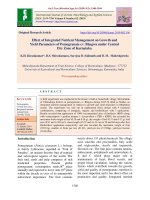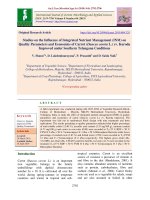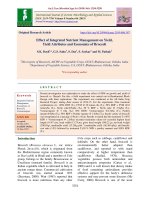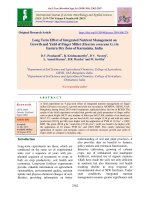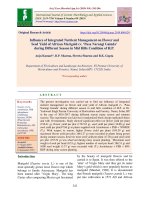Evaluate the effect of pesticide and integrated nutrient management system on the content of major nutrients in grain of rice-Pusa Basmati-1509 (Oryza sativa L.)
Bạn đang xem bản rút gọn của tài liệu. Xem và tải ngay bản đầy đủ của tài liệu tại đây (293.58 KB, 11 trang )
Int.J.Curr.Microbiol.App.Sci (2020) 9(8): 1574-1584
International Journal of Current Microbiology and Applied Sciences
ISSN: 2319-7706 Volume 9 Number 8 (2020)
Journal homepage:
Original Research Article
/>
Evaluate the Effect of Pesticide and Integrated
Nutrient Management System on the Content of Major Nutrients
in Grain of Rice -Pusa Basmati-1509 (Oryza sativa L.)
Anurag Dhankar1*, B.N. Tripathi1, Puspendra Kumar2, Anil Kumar1,
R. K. Pathak1, Ravi Dhanker1 and Vivek Kumar1
1
Department of Soil Science & Agriultural Chemistry, C.S. Azad University of Agriculture and
Technology, Kanpur-208 002 (Uttar Pradesh), India
2
Department of Agronomy, C.S. Azad University of Agriculture and Technology,
Kanpur-208 002 (Uttar Pradesh), India
*Corresponding author
ABSTRACT
Keywords
Pesticides,
Nutrients contents,
Integrated nutrient
management
Article Info
Accepted:
18 July 2020
Available Online:
10 August 2020
A field experiment was conducted during two consecutive years of Kharif2016
and 2017at Fertilizer Research Farm Uttari Pura, Chandra Shekhar Azad
University of Agriculture and Technology, Kanpur (Uttar Pradesh). The field
experiment was imposed to evaluate the effect of pesticide and integrated nutrient
management systems on the content of major nutrients in the grain of basmati rice
PB-1509. The importance of the NPK component is grater because they are found
in lower concentrations in most Indian varieties. The experiment was laid out in a
split-plot design comprise of four main plot and ten sub-plot, in which main plots
are: Control, Weedicide : Bispyribac Sodium (Nomnigold) 10 % SC @ 35 a.i. ha1
, Fungicides : IFC- 110 (Tricyclazole 45 % + Hexaconazole 10 % WG ) 1.0 g/
lit., Insecticides : Malathion 25% @ 25 kg ha-1, whereas the treatment
combinations in sub-plots are: N (T1 ), NP (T2 ), NPK (T3 ), NPK + Zn (T4 ),
NPK+ Fe (T5), NPK + Mn (T6 ), NPK+ Zn +Fe +Mn (T7 ), NPK +10 t FYM ha -1
(T8), NPK+ Zn +Fe +Mn + Vermicompost @ 3 ton ha-1 (T9 ), Control (T10 ).
Results have shown that treatment NPK+ Zn +Fe +Mn + Vermicompost @ 3 ton
ha-1 recorded significantly higher value of N, P, and K contents in the rest of the
treatment.
Introduction
Rice belongs to the genus Oryza and has two
cultivated and 22 wild species. The two
cultivated species are Oryza sativa Land
Oryza glaberrima. Rice is a major food grain
for more than a third of the world’s
population. It has been consumed by humans
for almost 5000 years (Zhao et al., 2011).
Rice holds a unique position among
1574
Int.J.Curr.Microbiol.App.Sci (2020) 9(8): 1574-1584
domesticated crop species as it is a staple
food and the first fully sequenced crop
genome. It is consumed mainly in the form of
whole-grain supplying 20% of daily calories
for the world population. An increasing
amount of available nutrients in rice food for
human consumption is a challenge that is
particularly important
for developing
countries. This could be achieved by
increasing the total level of nutrients in the
edible part of staple crops, such as rice grains
(Michael and Richard, 2007).
According to a report of FAO, (2016) world
population is growing at a rate of 160 persons
per minute and we need to produce 70 %
more food for an additional 2.3 billion people
by 2050. Agriculture is the fundamental mode
to satisfy the food demands of mankind and
soil is the only medium to practice
agriculture. To feed India's projected
population of 1.35 billion in 2025. In Basmati
rice aroma develops from a combination of
more than 100 volatile compounds
(Lewinsohn et al., 2001). Among over 100
volatile compounds that constitute aroma in
rice, 2-acetyl pyrroline (2-AP) is principally
responsible for the unique popcorn fragrance
of Basmati rice cultivars The detection of this
compound has been reported in different parts
of rice plants, except for the roots (Lorieux et
al., 1996). The structure of 2-AP consists of a
reactive methyl ketone group and a
nonreactive pyrroline group (Nadaf et al.,
2006). With the advent of molecular maps
and genomic sequences, a major gene for rice
aroma was discovered on chromosome 8. The
allelic variation at badh2 (betaine aldehyde
dehydrogenase homologue 2; a gene with 15
exons) controls the aroma in Basmati rice
(Sakthivel et al., 2009).
Traditionally, the optimum rate of Nfertilization has been the rate that results in
maximum economic yield. Required optimum
N rate varies with soil type, yield potential of
cultivar, levels of phosphorus (P) and K in the
soil, water management practices, and
intensity of diseases, insects, and weeds. The
use of adequate N rate is important not only
for obtaining maximum economic return, but
also to reduce environmental pollution (Singh
2008). Nitrogen is a key component of
chlorophyll, proteins, and enzymes; and
assists the plants in the synthesis and use of
carbohydrates (Sara et al., 2013). Split
applications of N are necessary for obtaining
high grain yield and improved quality (Kumar
et al., 2014).
Phosphorus plays a crucial role in the root
proliferation, consistent grain filling, and
higher grain yield, quality, and also being
involved in many processes such as
photosynthesis, mitotic activities, tissue
growth, and development. Plants cannot reach
their maximum yield without an adequate
supply of phosphorus (Murtaza et al., 2014).
Potassium is essential for the maintenance of
electrical potential across cellular membranes
and cellular turgor enhancing the cell
expansion and enlargement, opening and
closing of stomata, and pollen tube
development. The determination of optimum
levels of NPK fertilizers is essential for
obtaining maximum economic returns.
According to Ananthi et al., (2010) best rate
of fertilizer application is that which gives
maximum economic returns at the least cost.
The application of K increased gel
consistency and grain protein content but did
not
significantly
affect
gelatinization
temperature or kernel amylose content
(Bahmaniar and Ranjbar, 2007). Besides its
role in kernel quality, K fertilization is known
to improve stem strength and yield of Basmati
rice (Zaman et al., 2015).
Suwanarit et al., (1997) observed that aroma,
softness, whiteness, and glossiness in the
grain is dependent on P content in grain and
1575
Int.J.Curr.Microbiol.App.Sci (2020) 9(8): 1574-1584
not on P content in the plant. High dose P
application to the crop produced lower quality
grains. The application of P increased grain
protein content. Shivay et al., (2007) reported
that zinc fertilization had no deleterious effect
on the quality of Basmati rice. P even
increased hulling percentage and produced
longer and better grains.
Materials and Methods
At field experiment will be conducted at
Fertilizer research Farm Uttari Pura, of
Chandra Shekhar Azad University of
Agriculture & Technology, Kanpur for two
the consecutive year of 2015-16 and 201617in Kharif season. The initial Physicochemical and mechanical characteristics of
the experimental soil were: sand 57.66 %, silt
22.30 % and clay 20.14 %, mild high in
reaction (pH 8.32), and low EC 0.46 medium
in organic carbon (0.41%) with 182, 11.70
and 171.0 kg ha-1 of available N, P, and K,
respectively. DTPA extractable Zn, was 1.83
mg Kg-1, Fe 12.7, and Mn 7.26 mg Kg-1,
respectively.
Forty treatment combinations were replicated
three times in split-plot design. Surface (00.15 cm) soil samples taken after the harvest
of Rice were analyzed for pH, organic carbon,
cation exchange capacity, available N, P, and
K using standard analytical methods. Samples
were analyzed for their nitrogen content by
the modified Kjddahl method (Jackson 1973),
phosphorus
was
determined
by
vanadomolybdate, yellow color method, and
potassium by flame photometer in the di-acid
digest. Organic cation in post-harvest soil was
determined by Walkley and Black method.
Available
nitrogen,
phosphorus,
and
potassium in soil samples were determined by
the methods described by Subbiah and Asija
(1956), Olsen’s, and flame photometer
(Jackson, 1973), respectively.
All the treatments were evaluated in a splitplot design with three replications. Twentyone days old seedlings of 'Pusa Basmati-1509'
rice were transplanted in the third week of
July in each year with 20 x 10 cm row to row
and plant to plant spacing. The half dose on
nitrogen and full doses of P, K, Zn, Mn, and
Fe were applied as basal at the time of
transplanting through ammonium sulphate,
single super phosphate, Muriate of Potash
(MOP), MnSO4 and FeSO4, respectively and
remaining nitrogen was applied in two equal
splits at maximum tillering and panicle
initiation stage.
After taking the weight of total biomass, the
produce of each net plot was threshed
separated manually. The grains of each plot
were cleaned and air dried to maintain the
moisture content at a standard level of 14
percent and recorded the weight in kg per net
plot by balance. Finally, grain yield per plot
was converted into q/ha by the conversion
factor. The straw yield was recorded by
subtracting the weight of grains from the
weight of the total harvested produced of each
net plot.
Results and Discussion
Effect of pesticides application on N
content (%) in rice grain
It is evident from the Table 1 showed that
nitrogen content (%) in grain was influenced
significantly due to pesticides application
during first year but did not affected second
year of the study. It ranged varied from 1.159
to 1.232 percent during first year and 1.479 to
1.563 during second year. Among the
pesticides application the nitrogen content
was recoded significantly highest with the
range of 1.085 to 1.338 percent under the
application of Weedicide : Bispyribac Sodium
(Nomnigold)10 % SC @ 35 a.i. ha-1 at 4-6
leaves stage followed by Insecticides:
1576
Int.J.Curr.Microbiol.App.Sci (2020) 9(8): 1574-1584
Malathion 25% @ 25 kg ha-1 (1.053 to
1.306%) during first year. These applications
were also exhibited at par with each other.
The lowest nitrogen content in grain was
noticed in control treatment viz. 1.012 to
1.265% during first year.
compared to all the pesticides application.
The least nitrogen content was recorded in
control treatment during second year of the
observation. Similar result was also reported
by Singh et al., (2008), Singh, and Chhokar
(2009).
During second year, the application of
weedicide
:
Bispyribac
Sodium
(Nomnigold)10 % SC @ 35 a.i. ha-1 at 4-6
leaves stage was recorded statistically
maximum nitrogen content percent in grain as
compared to all the pesticides application.
The least nitrogen content was recorded in
control treatment during second year of the
observation. Similar finding was also reported
by Murali and Setty (2004) and (Yadav and
Raskar, 2011).
Effect of pesticides application on K
content (%) in rice grain
Effect of pesticides application on P
content (%) in rice grain
It is evident from the Table 2 showed that
phosphorus content (%) in grain was
influenced significantly due to pesticides
application during first year but did not
affected second year of the study. It ranged
varied from 1.159 to 1.232 percent during
first year and 1.479 to 1.563 during second
year. Among the pesticides application the
nitrogen content was recoded significantly
highest with the range of 1.085 to 1.338
percent under the application of Weedicide :
Bispyribac Sodium (Nomnigold)10 % SC @
35 a.i. ha-1 at 4-6 leaves stage followed by
Insecticides: Malathion 25% @ 25 kg ha-1
(1.053 to 1.306%) during first year. These
application was also exhibited at par with
each other. The lowest nitrogen content in
grain was noticed in control treatment viz.
1.012 to 1.265% during first year.
During second year, the application of
weedicide
:
Bispyribac
Sodium
-1
(Nomnigold)10 % SC @ 35 a.i. ha at 4-6
leaves stage was recorded statistically
maximum nitrogen content percent in grain as
It is evident from the Table 3 showed that
potassium content (%) in grain was
influenced significantly due to pesticides
application during both of the year of the
study.
The potassium concentration ranged varied
from 0.248 to 0.288 percent during first year
and 0.322 to 0.427 during second year.
Among the pesticides 0.352 percent under the
application of Weedicide : Bispyribac Sodium
(Nomnigold)10 % SC @ 35 a.i. ha-1 at 4-6
leaves stage followed by Insecticides:
Malathion 25% @ 25 kg ha-1 (0.187 to
0.337%) during first year. This application
was also exhibited significantly at par with
each other. The lowest nitrogen content in
grain was noticed in control treatment viz.
0.162 to 0.362% during first year.
During second year, the application of
weedicide : Bispyribac Sodium (Nomnigold)
10 % SC @ 35 a.i. ha-1 at 4-6 leaves stage
was
recorded
significantly maximum
potassium content percent in grain as
compared to all the pesticides application.
The minimum potassium content was
recorded in control treatment during second
year of the observation. Similar result was
also reported by Jha et al., (2004) and
Mahmud et al., (2016).
Effect of nutrients application on N content
(%) in rice grain
The data presented in table 1 revealed that
application of NPK+ Zn +Fe +Mn +
1577
Int.J.Curr.Microbiol.App.Sci (2020) 9(8): 1574-1584
Vermicompost @ 3 ton ha-1 significantly
increased the nitrogen concentration in grain
over control during first of the years but
observed non-significant effect in second
year. It ranged was between 1.051 to 1.305
percent during 2015-16 and 1.385 to 1.639%
during second year, respectively. The N
content was recorded maximum with the
application of NPK+ Zn +Fe +Mn +
Vermicompost @ 3 ton ha-1 which was
significantly superior over all the treatments
during first year. The least N content was
recorded under control plot which was not
received any nutrients.
Application of zinc, iron, manganese and
Zn+Fe+Mn+ vermicompost gave superior
values than corresponding nitrogen alone in
case of grain during first of the year.
In second year, as regards N concentration in
grain, the treatment, NPK+ Zn +Fe +Mn +
Vermicompost @ 3 ton ha-1 showed the
maximum N concentration and proved
statistically superior to rest of the treatments.
It was varied from 1.345 to 1.418 % and
1.599 to 1.672% under control to NPK+ Zn
+Fe +Mn + Vermicompost @ 3 ton ha-1.
Similar finding was also reported by Tripathi
et al., (2014) and Sudhakar (2016).
The lowest values of N concentration were
observed under control and highest in NPK+
Zn +Fe +Mn + Vermicompost @ 3 ton ha-1
during both the year.
All the treatments contained statistically
higher N content then control during both the
year of investigation. Addition of Zn, Fe, Mn
and combined with NPK and vermicompost
gave significantly higher grain N content over
rest of the treatments during both the year of
study. Similar result was also reported by
Bandyopadhyay et al., (2004).
Effect of nutrients application on P content
(%) in rice grain
The data presented in table 2 revealed that
application of NPK+ Zn +Fe +Mn +
Vermicompost @ 3 ton ha-1 significantly
increased the phosporus concentration in
grain over control during both of the years . It
ranged was between 0.180 to 0.330 percent
during 2015-16 and 0.247 to 0.388% during
second year, respectively.
The P content was recorded maximum with
the application of NPK+ Zn +Fe +Mn +
Vermicompost @ 3 ton ha-1 which was
significantly superior over all the treatments
during first year. The least P content was
recorded under control plot which was not
received any nutrients. Application of zinc,
iron,
manganese
and
Zn+Fe+Mn+
vermicompost gave superior values than
corresponding nitrogen alone in case of grain
during first of the year.Similar result was also
reported
byand
Sudhakar
(2016)and
Srivastava et al., (2016).
In second year, as regards P concentration in
grain, the treatment, NPK+ Zn +Fe +Mn +
Vermicompost @ 3 ton ha-1 showed the
maximum P concentration and proved
significantly superior to rest of the treatments.
It was varied from 0.227 to 0.377 % and
0.267 to 0.417% under control to NPK+ Zn
+Fe +Mn + Vermicompost @ 3 ton ha-1. The
lowest values of P concentration in grain were
observed under control and highest in NPK+
Zn +Fe +Mn + Vermicompost @ 3 ton ha-1
during both the year. All the treatments
contained significantly higher P content then
control during both the year of investigation.
Addition of Zn, Fe, Mn and combined with
NPK and vermicompost gave significantly
higher grain P content over rest of the
treatments during both the year of study.
Similar findings was also reported by Tripathi
et al., (2014).
1578
Int.J.Curr.Microbiol.App.Sci (2020) 9(8): 1574-1584
Table.1 Effect of pesticide and nutrient applications on N content (%) in grain of rice crop during 2015-16 and 2016-17
Treatments
N
NP
NPK
NPK +Zn
NPK+ Fe
NPK + Mn
NPK+ Zn +Fe +Mn
NPK +10 t FYM ha-1
NPK+ Zn +Fe +Mn +
Vermicompost @ 3 t ha-1
Control
Mean
SEm
CD @ 5%
CV
N content (%) in grain
2015-16
Control Weedicide Fungicides
1.080
1.153
1.121
1.129
1.199
1.166
1.155
1.228
1.196
1.177
1.250
1.218
1.170
1.243
1.211
1.168
1.241
1.209
1.204
1.276
1.244
1.233
1.306
1.274
1.265
1.338
1.306
1.012
1.159
W
0.011
0.038
5.06
1.085
1.232
N
0.009
0.026
6.72
1.053
1.200
Insecticides
1.125
1.171
1.200
1.222
1.215
1.213
1.248
1.275
1.311
Mean
1.119
1.166
1.195
1.217
1.210
1.207
1.243
1.272
1.305
1.057
1.204
1.051
1579
2016-17
Control Weedicide Fungicides Insecticides Mean
1.413
1.486
1.458
1.454
1.453
1.429
1.532
1.504
1.499
1.491
1.455
1.561
1.533
1.529
1.520
1.511
1.584
1.556
1.552
1.550
1.504
1.577
1.549
1.545
1.543
1.501
1.574
1.546
1.542
1.541
1.471
1.576
1.515
1.578
1.535
1.567
1.648
1.608
1.608
1.608
1.599
1.672
1.645
1.640
1.639
1.345
1.479
W
0.034
NS
12.09
1.418
1.563
N
0.026
NS
15.03
1.390
1.530
1.386
1.533
1.385
Int.J.Curr.Microbiol.App.Sci (2020) 9(8): 1574-1584
Table.2 Effect of pesticide and nutrient applications on P content (%) in grain of rice crop during 2015-16 and 2016-17
Treatments
N
NP
NPK
NPK +Zn
NPK+ Fe
NPK + Mn
NPK+ Zn +Fe +Mn
NPK +10 t FYM ha-1
NPK+ Zn +Fe +Mn +
Vermicompost @ 3 t
ha-1
Control
Mean
SEm
CD @ 5%
CV
P content (%) in grain
2015-16
2016-17
Control Weedicide Fungicides Insecticides Mean Control Weedicide Fungicides Insecticides Mean
0.180
0.220
0.195
0.205
0.247
0.287
0.262
0.272
0.200
0.267
0.220
0.260
0.235
0.245
0.287
0.327
0.302
0.312
0.240
0.307
0.240
0.280
0.255
0.265
0.307
0.347
0.322
0.332
0.260
0.327
0.270
0.310
0.285
0.295
0.337
0.377
0.352
0.362
0.290
0.357
0.260
0.300
0.275
0.285
0.327
0.367
0.342
0.352
0.280
0.347
0.250
0.290
0.265
0.275
0.317
0.357
0.332
0.342
0.270
0.337
0.290
0.330
0.305
0.315
0.357
0.397
0.372
0.382
0.310
0.377
0.280
0.320
0.295
0.305
0.347
0.387
0.362
0.372
0.300
0.367
0.310
0.350
0.325
0.335
0.377
0.417
0.358
0.402
0.330
0.388
0.160
0.246
W
0.005
0.017
10.30
0.200
0.286
N
0.004
0.010
11.88
0.175
0.261
0.185
0.271
1580
0.180
0.227
0.313
W
0.007
0.026
12.30
0.267
0.353
N
0.009
0.024
22.39
0.242
0.324
0.252
0.338
0.247
Int.J.Curr.Microbiol.App.Sci (2020) 9(8): 1574-1584
Table.3 Effect of pesticide and nutrient applications on K content (%) in grain of rice crop during 2015-16 and 2016-17
Treatments
N
NP
NPK
NPK +Zn
NPK+ Fe
NPK + Mn
NPK+ Zn +Fe +Mn
NPK +10 t FYM ha-1
NPK+ Zn +Fe +Mn +
Vermicompost @ 3 t ha-1
Control
Mean
SEm
CD @ 5%
CV
K content (%) in grain
Control
0.182
0.222
0.242
0.272
0.262
0.252
0.292
0.282
0.312
0.162
0.248
W
0.007
0.026
15.29
Weedicide
0.222
0.262
0.282
0.312
0.302
0.292
0.332
0.322
0.352
0.202
0.288
N
0.008
0.023
26.07
2015-16
2016-17
Fungicides Insecticides Mean Control Weedicide Fungicides Insecticides Mean
0.197
0.207
0.290
0.357
0.317
0.325
0.202
0.322
0.237
0.247
0.317
0.391
0.323
0.372
0.242
0.351
0.257
0.267
0.324
0.411
0.329
0.382
0.262
0.361
0.287
0.297
0.333
0.440
0.337
0.406
0.292
0.379
0.277
0.287
0.327
0.430
0.334
0.393
0.282
0.371
0.267
0.277
0.318
0.428
0.331
0.384
0.272
0.365
0.307
0.317
0.354
0.480
0.378
0.437
0.312
0.412
0.297
0.307
0.332
0.468
0.344
0.424
0.302
0.392
0.327
0.337
0.365
0.514
0.419
0.475
0.332
0.443
0.177
0.263
0.187
0.273
1581
0.182
0.262
0.322
W
0.008
0.028
12.09
0.351
0.427
N
0.005
0.015
12.29
0.310
0.342
0.290
0.389
0.303
Int.J.Curr.Microbiol.App.Sci (2020) 9(8): 1574-1584
Effect of nutrients application on K content
(%) in rice grain
The data presented in table 3 revealed that
application of NPK+ Zn +Fe +Mn +
Vermicompost @ 3 ton ha-1 significantly
increased the potassium concentration in grain
over control during both of the years. It
ranged was between 0.182 to 0.332 percent
during 2015-16 and 0.303 to 0.443% during
second year, respectively.
The K content was recorded maximum with
the application of NPK+ Zn +Fe +Mn +
Vermicompost @ 3 ton ha-1 which was
significantly superior over all the treatments
during first year. The least K content was
recorded under control plot which was not
received any nutrients. Application of zinc,
iron,
manganese
and
Zn+Fe+Mn+
vermicompost gave superior values of K
content than corresponding nitrogen alone in
case of grain during first of the year. Similar
result was also reported by Kumar et al.,
(2014) and Tripathi et al., (2014).
In second year, as regards K concentration in
grain, the treatment, NPK+ Zn +Fe +Mn +
Vermicompost @ 3 ton ha-1 showed the
maximum K concentration and proved
significantly superior to rest of the treatments.
It was varied from 0.262 to 0.351 % and
0.312 to 0.352% under control to NPK+ Zn
+Fe +Mn + Vermicompost @ 3 ton ha-1. The
lowest value of K concentration in grain was
observed under control and highest in NPK+
Zn +Fe +Mn + Vermicompost @ 3 ton ha-1
during both the year. All the treatments
contained significantly higher K content then
control during both the year of investigation.
Addition of Zn, Fe, Mn and combined with
NPK and vermicompost gave significantly
higher grain K content over rest of the
treatments during both the year of study.
Similar result was also reported by Singh et
al., (2009), Tripathi et al., (2014)
In conclusion, it is evident from the data
Tables that N, P, K varied from with mean
value of 1.051- 1.639 %, 0.180-0.388 % and
0.182-0.443, respectively. Imbalance use of
major and micro nutrient either omission of
N, P, K or though farmers fertilizer practices
causes poor nutrition status/ availability of
nutrients resulting adverse impact on
productivity of rice grain as well as lower N,P
and K contents. Use of pesticides viz.
Weedicides, Insecticides and fungicides along
with Vermicompost and fertilizer nutrients
recorded highest nutrients content in grain of
‘Pusa Basmati-1509’ in irrigated transplanted
system. Imbalance use of major nutrient and
pesticides causes poor nutrition status/
availability of nutrients resulting adverse
impact on N, P and K contents in grain of
rice.
References
Ananthi
T.,
Amanullah
MM.,
and
Subramanian KS., (2010). Influence of
mycorrhizal and synthetic fertilizers on
soil nutrient status and uptake in hybrid
maize. Mad. Agric. J. 97:374-378
Bahmanyar, M.A. and Ranjbar, G.A. (2007).
Response of rice cultivar to rates of
nitrogen and potassium application in
field and pot conditions. Pakistan J. of
biolo. Sci., 10 (9): 1430- 1437.
Bandyopadhyay, K.K., Tripathi, A.K., Hati,
K.M., Mishra, A.K. and Acharya, C.L.
(2004). Comparative effectiveness of
cattle
manure,
poultry
manure,
phosphocompost and fertilizer-NPK on
three cropping systems in Vertisols of
semi-arid tropics. I. crop yields and
system
performance.
Bioresour
Technol., 95: 77-83.
Black, C.A. (1965). Methods of soil analysis.
American Society of Agronomy,
Monography 9, Madison, Wisconsin,
pp. 1572.
Bouyoucos G.J. (1962). Hydrometer method
1582
Int.J.Curr.Microbiol.App.Sci (2020) 9(8): 1574-1584
improved for making particle analysis
of soils. Agronomy J., 54: 464.
Chandel, S.R.S. (1998). Advance agriculture
statics, 2nd Edition, Kalyani Publication
FAO (2016). Rice Market Monitor. Volume
Xix Issue. Food and Agriculture
Research Organisation (FAO) of the
United Nation (Rome).
Jackson, M.L. (1967). Soil chemical analysis.
Prentice Hall of India Pvt. Ltd., New
Delhi, pp. 498.
Jha, S.K., Tripathi, R.S. and Malaiya, S.
(2004). Influence of integrated nutrient
management practices on growth and
yield of scented rice (Oryza sativa L.).
Agricultural Research New Series, 25
(1): 159-161
Kumar, A., Meena, R.N., Yadav, L. and
Gilotia, Y.K. (2014). Effect of organic
and inorganic sources of nutrient on
yield, yield attributes and nutrient
uptake of rice CV. PRH-10. The
bioscan. 9 (2): 595-597.
Kumar, V., Mahajan, G., and Sharma, N.,
(2014). Influence of rate and time of
nitrogen application on the yield and
quality characteristics of basmati rice
(Oryza sativa L.). Ecol. Environ.
Conserv. 20, 1723-1729.
Kumar, R., and Nagrajan S., (2004). RiceWheat Cropping system: food security
and sustainability. current science 87,
1334-1335.
Lewinsohn, E., Schalechet, F., Wilkinson, J.,
Matsui, K., Tadmor, Y., Nam, K.H.,
Amar, O., Lastochkin, E., Larkov, O.,
and Ravid, U., (2001). Enhanced levels
of the aroma and flavor compound Slinalool by metabolic engineering of the
terpenoid pathway in tomato fruits.
Plant Physiol.127, 1256-1265.
Mahmud, A. M., Shamsuddoha, A.T.M.,
Issak, M. Haque M. N. and Achakzai,
A.
K.K.
(2016).
Effect
of
Vermicompost and Chemical Fertilizer
on the Nutrient Content in Rice Grain,
Straw and Post Harvest Soil. MiddleEastJ. Sci. Res., 24(2): 437-444.
Michael, B. Z., and H.F. Richard, (2007).
Nutritional iron deficiency, 370 (5):1120.
Murali, M.K. and Setty, R.A., (2004). Effect
of
fertilizer,
vermicompost
and
triacontanol on growth and yield of
scented rice. Oryza, 41 (1&2): 57-59.
Murtaza., Ghulam & Ehsanullah., & Zohaib.,
Ali & Hussain., Sajid & Rasool.,
Tassadduq & Shahzad., and Haroon.,
(2014). The influence of rhizobium seed
inoculation and different levels of
phosphorus application on growth, yield
and quality of mashbean (Vigra mungo
L.). International Journal of Modern
Agriculture. 3. 2305-7246.
Nadaf, A.B., Krishnan, S., and Wakte, K.V.,
(2006). Histochemical and biochemical
analysis of major aroma compound (2acetyl-1-pyrroline) in basmati and other
scented rice (Oryza sativa L.). Curr.
Sci.91, 1533-1536.
Olsen, S.R., Cole, C.l., Watanabe, F.S., and
Dean, D.A., (1954). Estimation of
available phosphorus in soils by
extraction with sodium bicarbonate.
USDA, Circ,pp. 939
Sakthivel, K., Sundaram, R.M., Rani, N.S.,
Balachandran, S.M., and Neereja, C.N.,
(2009). Genetic and molecular basis of
fragrance in rice. Biotechnol. Adv. 27,
468-473.
Sara S., Morad M., and Reza CM (2013).
Effects of seed inoculation by
Rhizobium strains on chlorophyll
content and protein percentage in
common bean cultivars (Phaseolus
vulgaris L.). Intl. J. Biosci.; 3:1-8
Shivay, Y.S., Kumar, D., Ahlawat, I.P.S., and
Prasad, R., (2007). Relative efficiency
of zinc oxide and zinc sulphate coated
urea for rice. Indian J. Fert.3, 51-56.
Singh, F. Kumar R., and Pal, S., 2008.
Integrated nutrient management in rice-
1583
Int.J.Curr.Microbiol.App.Sci (2020) 9(8): 1574-1584
wheat cropping system for sustainable
productivity. J. Indian Soc. Soil Sci.,56:
205-208.
Singh, S., Chhokar R.S., Gopal, R. and
Kumar, V. (2009b). Integrated weed
management- a key for success of direct
seeded rice in the Indo - Gangetic
Plains. Int. Rice Research Institute
(IRRI), Los Banos, Philippines, pp. 261278
Singh, R. and Sinha, A.P. (2004).
Comparative
efficacy
of
local
bioagents, commercial bio- formulation
and fungicide for the management of
sheath blight of rice under glass house
conditions. Indian Phytopathology, 57:
494-496.
Srivastava, P., Srivastava, P.C. and Singh
U.S. (2009). Effect of integrated and
balanced nutrient application on soil
fertility, yield and quality of Basmati
rice. Archives of Agronomy and Soil
Science, 55(3): 265-284.
Stanford, S and L. English. (1949). A use of
Flame Photometer in rapid soil tests of
K and Ca. Agron. J., 41: 446-447.
Subbiah, B.V. and Asija, G.L. (1956).
Procedure for estimation of available
nitrogen in soil. Curr. Sci., 25:259-260
Sudhakar, P. (2016). Effect of Different
Vermicomposts on the Yield, Nutrient
Uptake and Nitrogen Use Efficiency in
Sri Method of Rice Cultivation. Intel. J.
Tropical Agric. 34 (4): 885-888.
Suwanarit, A., Kreetapirom, S., Buranakarn,
S., Varany Anond, W., and Tungtrakul,
P. (2007). Global health risks. Mortality
and burden of disease attributable to
selected major risks. WHO Library
Cataloguing-in-Publication Data.
Tripathi, B.N., Yadav, V.K. and Tripathi,
H.C. (2014). Production potential of
rice–wheat crops as influenced by zinc
management in partially reclaimed
sodic soil. Ann. Pl. Soil Res., 17(1): 8285.
Yadav, O.M. and Raskar, S.K. (2011). Effect
of organic and inorganic nutrient
management on productivity of rice
(Oryza sativa) under upland ecosystem.
Current Advances in Agricultural Scie.,
3 (2):143-145.
How to cite this article:
Anurag Dhankar, B.N. Tripathi, Puspendra Kumar, Anil Kumar, R.K. Pathak, Ravi Dhanker
and Vivek Kumar. 2020. Evaluate the Effect of Pesticide and Integrated Nutrient Management
System on the Content of Major Nutrients in Grain of Rice -Pusa Basmati-1509 (Oryza sativa
L.). Int.J.Curr.Microbiol.App.Sci. 9(08): 1574-1584.
doi: />
1584

